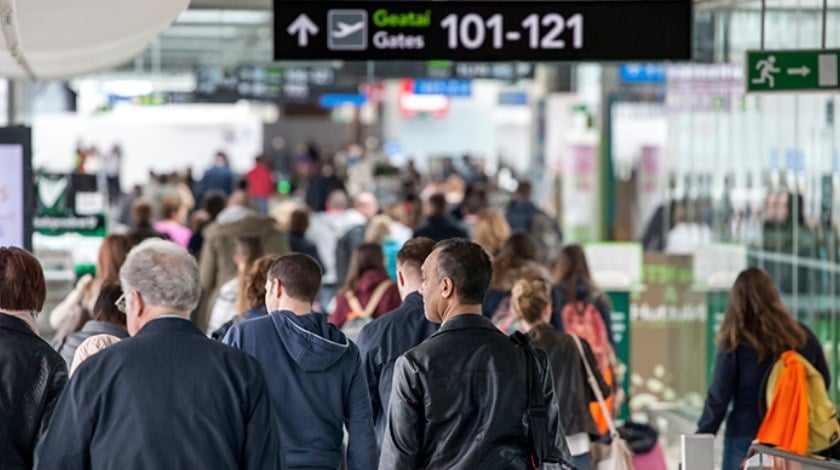Photo: dubplus.ie
Reading Time: 4 minutesEuropean airport trade body, ACI EUROPE today released its airport traffic report for June, Q2 and the first half of 2016.
The report is the only air transport report, which includes all types of civil aviation passenger flights: full service, low cost and charter. It reveals that during the first half of this year, passenger traffic at Europe’s airports grew by an average +4.9%.
More specifically, passenger traffic in the EU during H1 (the first half of the year) grew by a robust +6.2%. Growth dynamics varied between EU countries, with the core markets of France, Germany and Italy underperforming the EU average while Bulgaria, Cyprus, Denmark, Hungary, Ireland, Lithuania, Luxembourg, Malta, Portugal, Romania and Spain all achieved double digit growth.
However, the pace of growth diminished between the first and the second quarter from +8.2% to +4.8%. This affected almost all EU markets – and especially Belgium in the wake of the Brussels terrorist attacks.
A large part of that growth was concentrated on secondary hubs & large to mid-sized airports, such as Berlin-Schonefeld (+39.4%), Cologne-Bonn (+19.8%), Bucharest (+16.5%), Dublin (+13.4%), Barcelona (+12.7%), Birmingham (+12.6%), Budapest (+11.9%) and Copenhagen (+10.9%).
Meanwhile, among the Top 5 busiest EU airports, traffic growth at London-Heathrow, Paris CDG and Frankfurt stalled, while Amsterdam-Schiphol (+9.9%) and Madrid (+8.6%) reported impressive increases. This generally reflects the fact that Low Cost Carriers remain the main drivers of traffic expansion for EU airports, as well as airport capacity constraints.
Shift in the leisure market benefiting some EU airports
EU airports serving leisure destinations also fared very well, benefitting from demand shifting away from North Africa and Turkey. This was the case in particular of Bourgas (+25.2%), Varna (+24.3%), Larnaca (+20.8%), Faro (+18.6%), Santorini (+17.9%), Ibiza (+17%), Alicante (+16.1%), Dubrovnik (+15.2%), Malaga (+14.6%), Funchal (+14%), Chania (+14.5%), Gran Canaria (+14.2%), Palma de Mallorca (+11.2%) and Malta (+10.2%).
Non-EU growtg tells a different story
Conversely, passenger traffic in the non-EU bloc was almost flat at +0.5%, dragged down by significant losses in Turkey and Russia.
These losses materialised in the second quarter, bringing down non-EU passenger traffic by -3.2%, and worsening in June to -6.9%.
Meanwhile, Iceland reported unprecedented growth – with Keflavik airport seeing passenger traffic increasing by +34.3% – followed by FYROM, Moldova, Ukraine and Israel.
Freight traffic across the European airport network in H1 increased by just +2.1%. EU airports posted a +3.2% increase, with a significant jump in June (+6.4%) while Non-EU airports posted a –3.9% decrease over the same period and a dramatic fall in June (-13.5%). Aircraft movements were up +3.1%.
Olivier Jankovec, Director General ACI EUROPE commented “Beyond an overall healthy traffic performance at pan-European level for the first 6 months of the year, these figures reveal a severe slump in passenger demand in the Non-EU bloc affecting mainly Turkey and Russia – as well as a significant growth deceleration in the EU market.
In both cases, these worrying trends are due to the impact of terrorism and accrued geopolitical instability. Since these traffic figures do not yet reflect the full impact of the Istanbul-Atatürk airport terrorist attack and the failed coup in Turkey, we expect a further worsening of airport traffic performance over the summer and for the remainder of the year.
EU airports are also likely to see a continued softening of passenger traffic on the back of lower consumer confidence fuelled by terrorism and the decision of the UK to leave the EU, as well as major full service airlines reining in capacity. The only positive remains the price of oil – which should help limit the extent of capacity cuts and keep low cost carriers in expansion mode”.
During the first 6 months of the year (H1), airports welcoming more than 25 million passengers per year (Group 1), airports welcoming between 10 and 25 million passengers (Group 2), airports welcoming between 5 and 10 million passengers (Group 3) and airports welcoming less than 5 million passengers per year (Group 4) reported an average adjustment +3.3%,
+5.4%, +9.7% and +5.8%.
The airports which reported the highest increases in passenger traffic during H1 are as follows:
GROUP 1: Dublin (+13.4%), Barcelona (+12.7%), Istanbul SAW (+12.0%), Copenhagen (+10.9%) and Amsterdam (+9.9%)
GROUP 2: Cologne-Bonn (+19.8%), Alicante (+16.1%), Malaga (+14.6%), Gran Canaria (+14.2%) and Birmingham (+12.6%)
GROUP 3: Berlin SXF (+39.4%), Larnaca (+20.8%), Faro (+18.5%), Ibiza (+17.0%) and Bucharest OTP (+16.5%)
GROUP 4: Oradea (+283.4%), Liege (+170.9%), Ostend (+127.5%), Iasi (+115.2%) and Ohrid (+82.7%)
June figures
During the month of June, average passenger growth was +2.3%, with EU airport traffic growth (+5.1%) counterbalancing losses at Non-EU airports (-6.9%). Meanwhile, freight reported an increase of +1.7% and movements were up +1.4%.
Airports welcoming more than 25 million passengers per year (Group 1), airports welcoming between 10 and 25 million passengers (Group 2), airports welcoming between 5 and 10 million passengers (Group 3) and airports welcoming less than 5 million passengers per year (Group 4) reported an average adjustment -1.1%, +4.6%, +8.2% and +2.8%.
For June, the airports which reported the highest increases in passenger traffic are as follows:
GROUP 1: Barcelona (+10.0%), Dublin (+9.6%), Copenhagen (+8.9%), London LGW (+8.5%) and Amsterdam (+7.9%)
GROUP 2: Gran Canaria (+22.3%), Alicante (+15.8%), Malaga (+14.2%), Birmingham (+13.2%) and Cologne-Bonn (+12.5%)
GROUP 3: Berlin SXF (+31.8%), Larnaca (+22.9%), Tenerife TFS (+18.6%), Kiev (+16.5%) and Faro (+16.3%)
GROUP 4: Oradea (+3,266.7%), Bucharest BBU (+213.7%), Iasi (+111.0%), Palanga (+68.3%) and Chambery (+55.3%)
The ‘ACI EUROPE Airport Traffic Report – June, Q2 & H1 2016’ includes 215 airports in total representing more than 88% of European air passenger traffic.

